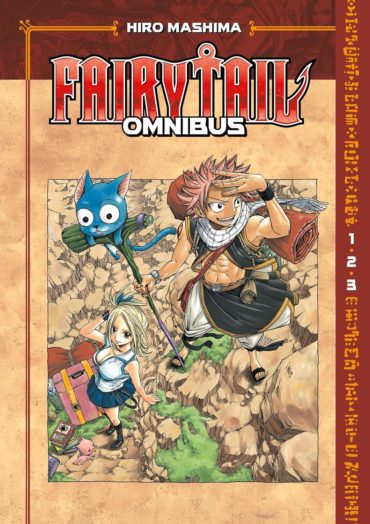Fairy Tail Omnibus 1 (Volumes 1-3) Review
Fairy Tail is one of the better shonen series to have been released in the 21st century so far, and certainly one of the best to have come from outside the dominant Weekly Shonen Jump empire, instead coming from Weekly Shonen Magazine. However, while the series is good, I’m somewhat unsure about the need for this new omnibus collection.
For those who have not read Fairy Tail before or seen the anime adaptation of it, the series is set in the fantasy kingdom of Fiore. It begins with Lucy Heartfilia, who works as a “celestial” wizard – one who uses magic keys to summon up powerful beings based on the constellations. She desires to join a guild of wizards known as “Fairy Tail”, which she ends up doing after a fateful encounter with one of its members, Natsu Dragneel. Natsu uses “dragon slayer” magic, taught to him by Igneel, a dragon who raised him as a child, and helps Lucy out when some villains try to trick Lucy into thinking they are Fairy Tail members when they aren’t.
Together, along with Natsu’s trusty winged cat friend Happy, Lucy is taken to the Fairy Tail guild, which turns out not to be as wholesome as she first thought. Several of the other guild members, including Natsu, are too destructive for their own good, or have other issues. Natsu, for example, suffers from chronic motion sickness resulting in him feeling ill whenever he gets onto any mode of transport. He also has a hatred of fellow guild member Gray Fullbuster, a user of ice magic who is constantly stripping his clothes off; while both of them are terrified of no-nonsense Erza Scarlet, one of the strongest of all the wizards of the guild whose “requip” magic allows her to swap into different suits of armour, each with its own different powers.
Lucy, Natsu, Gray, Erza and Happy soon find themselves working together on various missions, although they have personal goals too. While Lucy is keen to find more keys to use in her magic, Natsu is trying to find Igneel, who suddenly went missing one day when he was younger and hasn’t been seen since. As for working together as a group, the main story in this collection sees them going into battle with an evil “dark guild” called Eisenwald, who are after a flute called “Lullaby” which causes people to die whenever they hear the music coming from it.
Given how many past reviews there have been of Fairy Tail on AUKN, I’m not going to go into great detail regarding the plot of the story in this review, as there are plenty of articles you can search through at your own leisure if you want to drill down into this aspect, including reviews I myself have done of the anime. My main interest in this review is in terms of the production carried out by Kodansha. This omnibus edition appears to keep the same translation as the first releases of the series, done by William Flanagan. There seems to be nothing wrong with it, and Flanagan does provide some useful translations in the text during the story (e.g., giving a brief translation that “Eisenwald” means “Iron Forest” in German). The lettering is fine, but is nothing spectacular; and each of the individual volumes comes with some nice translation notes.
However, as mentioned earlier, I fail to see why you would need to get this omnibus edition, other than as a useful way of introducing you to Fairy Tail, mainly because I think previous releases of the series are better. One problem with this omnibus is that rather than releasing it in the standard tankobon B6 page size (125 x 176mm), Kodansha have brought out this book in a larger A5 size (148 x 210mm). This wouldn’t be a problem if it was just individual volumes or it was a sturdy hardback, but this is a as-near-as-damn-it 600-page paperback. It just feels cumbersome to hold. It doesn’t make for the best reading experience. Kodansha did previously release some of the story as a “Master’s Edition”, which was an even larger version. Perhaps they were thinking of scaling back down from this?
What is more, there are so many other ways you can read Fairy Tail. While the omnibus is only available in print, you can read individual volumes in either print or digital, and if you have access to certain website subscriptions, you can read these volumes for free, so why fork out for this bulky book to sample the series when you can do it for nothing and save space on your bookshelf? Alternatively, if you want physical copies, there are larger box sets of the series you can also purchase in the standard tankobon size which make for more comfortable reading.
While Fairy Tail itself is a good series, and one I would certainly recommend, there are better ways to read it. This omnibus doesn’t feel like the best introduction of the series to new readers, and personally I would go down alternative routes to try and make this story appeal to those who have yet to come to it.


